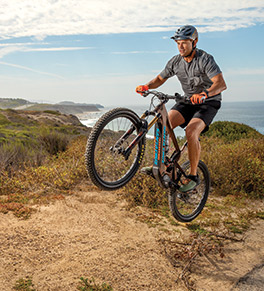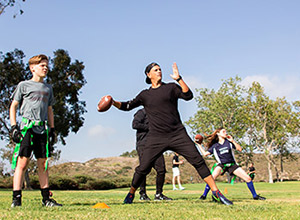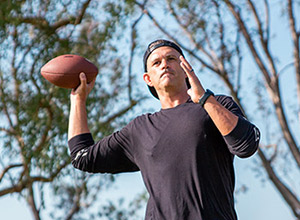Rare spine surgery restores elite athlete's mobility

Vince Bruno is back on his bike and is able to surf, hike and pass a football with full mobility after complex spine surgery performed by UCI Health spine surgeon Dr. Nitin Bhatia. Photo by Michael Neveux for UCI Health
While mountain biking on the morning of his 47th birthday, Vince Bruno hit a stump on a backcountry trail, flew over the handlebars and crashed headfirst into a rock.
As a multisport athlete — Bruno had been a linebacker signed as a free agent with the Miami Dolphins in 1997 and won two world championships in Brazilian jujitsu — the Newport Beach resident was no stranger to pain and injuries. But this time, he was paralyzed from the neck down.
“I couldn’t move my arms or legs for several minutes. Then my legs began flopping around involuntarily.”
The accident in June 2021 revealed a severe constriction of his spinal cord in the neck area, a condition he likely had had for years, but was made worse by his fall. Called spinal stenosis, it was a condition several doctors told him required immediate surgery to avoid permanent paralysis, even death.
Reluctant to risk his mobility, Bruno sought alternatives. Ultimately, his confidence in UCI Health spine surgeon Dr. Nitin Bhatia — one of a handful of U.S. spine surgeons able to perform a rare and complex procedure called spinal laminoplasty — won the day. Bhatia not only clearly detailed the alternative to traditional spinal fusion surgery that had been recommended, he also empathized with the athlete’s conflicted feelings.
“For patients, decisions like these are scary,” says the spine specialist, who also serves as a professor and chair of the UCI School of Medicine’s Department of Orthopaedic Surgery.
“It’s important to explain things carefully and in a manner that gives them time to process and reach a decision that is right for them and their families," Bhatia adds. "We physicians — especially as society becomes more detached with digital devices, computers and video visits — have to remember that our primary goal is to take care of the patient, not just their spine.”
Confronting a frightening injury
Within minutes after pitching head first off his bike, as Bruno began to regain some control of his extremities, he was discovered by two men who helped him walk 2½ miles back to the trailhead.
From there, his wife Amy and a friend took him to the nearest emergency room, where he was told he needed immediate surgery because his spinal canal was pinching the nerves in his neck. But Bruno had a flag football game to coach that evening and his team of fourth graders were depending on him.
“I always told them not to give up, so I had to show up for them,” he says. Remarkably, he coached their game wearing a neck brace, but only after signing a waiver and promising the emergency room staff that he would return after the game to get an MRI.
Bruno kept that promise, but when every doctor he saw at the emergency room recommended immediate spinal surgery, he resisted. “I believe my body is made a certain way, and I didn’t want to open it up and change things. I was concerned that my range of motion would change with surgery.”
Bruno’s neighbor, UCI Health colorectal surgeon Dr. Joseph Carmichael, strongly encouraged him to see Bhatia. At their appointment, Bhatia explained that without surgery, any additional injury could result in permanent paralysis.
Although he scheduled a surgery with Bhatia, he also consulted another orthopedist favored by many professional athletes, hoping to find an alternative to surgery. That specialist offered the same diagnosis, but said he didn’t perform the type of procedure Bruno needed, spinal laminoplasty. He said only a handful of surgeons in the country could perform the delicate procedure and that best happened to be his wife’s surgeon: Dr. Nitin Bhatia.
Hearing that endorsement "pushed me over the edge,” says Bruno. “I understood that I needed this surgery, no matter what.” In November 2021, he underwent the unique procedure to treat his spinal stenosis yet preserve his mobility.
Understanding spinal stenosis
Spinal stenosis occurs when the spinal canal, the space between each vertebrae, narrows and puts pressure on the column of nerve tissue running the length of the spine. “You can think of the spinal canal as a pipe,” Bhatia says. “Normally it’s about a ½- or ¾-inch wide, but Vince’s was about half of that or less.”
The condition can exist at birth. But it is more often age-related or develops in athletes like Bruno, whose bones grow thicker in response to weightlifting or other sports. The biking accident caused his already narrowed canal to pinched his nerves further, temporarily paralyzing him.
“The goal for someone like Vince was to take the pressure off the spinal cord,” says Bhatia. “We didn’t want any small accident to cause him to be paralyzed forever.”
Spinal fusion is the most common procedure for cervical spinal stenosis. Although outcomes are generally successful, Bhatia says Bruno’s narrowed canal affected four vertebrae levels — from C3 to C7 — not just two, as in most cases.
“If Vince had traditional spinal fusion surgery, those levels would be locked together with metal plates, and he would lose a lot of range of motion,” the surgeon says.
Spinal laminectomy is another option, but would still limit the patient's range of neck motion. For this procedure, the surgeon cuts away all the bone and fuses the cervical area with screws.
Laminoplasty: an ‘elegant’ alternative
In the procedure Bhatia proposed — spinal laminoplasty, also called open-door laminoplasty — bone is not removed but instead is cut and repositioned.
“If you look at a typical door, there are hinges on one side,” Bhatia says. “If you open that door halfway, there’s a 45-degree opening opposite the hinges. That extra space is where the spinal cord can now go. Although we do use some very small metal plates — almost like a kickstand to hold that door open — we do not fuse one level of bone to the next.
“We allow the structure to remain, and the body heals to it. It’s a very elegant solution to a very bad problem.”
Although rarely performed in the United States, the surgery is commonplace in Japan, says Bhatia, whose 2015 study in the journal Clinical Neurology and Neurosurgery showed excellent results achieved in initial U.S. laminoplasties.
The UCI Health spine team now does more laminoplasties than most other U.S. spine centers, he says.
Back in play
After his surgery in November 2021, Bruno stayed in the hospital four days to ensure that his pain levels were properly managed, an experience he described as “like being in a five-star hotel.” Within a matter of days, he was venturing on walks.
Bruno praises the UCI Health spine team’s skill for his successful surgery. As important, he says, is Bhatia’s respect for his reluctance to undergo any procedure that might affect his mobility.
“He never made me feel pressure to get the surgery but simply gave me the information I needed. I’m glad I went through the process and didn’t rush my decision. That was the right call for me.”
Bhatia credits the entire UCI Health team with Bruno’s recovery. “Our surgeons have great training to diagnose spinal problems and know who would actually benefit from surgery and who would not. We also have great partners: our physical therapists, pain management doctors and physical medicine doctors.”
A year after his mountain biking accident, Bruno is working out daily, running, biking or surfing. And while he admits “to being a little more cautious on the jujitsu side,” he plans to participate in one more competition.
Through it all, he has continued to coach flag football in Newport Beach, including his now 11-year-old son Bronson’s team, the Seahawks, still modeling a can-do attitude for his players.
After throwing passes and demonstrating various plays at a recent Seahawks practice, Bruno says he’s grateful to have his athletic lifestyle back.
“I no longer have to worry about being paralyzed. And I’m feeling the best I’ve felt in 15 or 20 years.”








